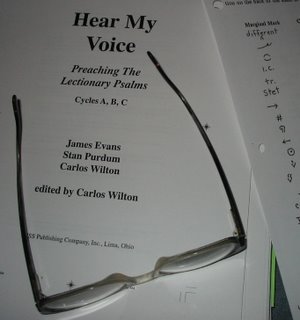 I spend a great deal of time today checking over the galley proofs of a book I’ve edited, Hear My Voice: Preaching the Lectionary Psalms. It’s a collection of columns from the preaching journal, Emphasis, that have appeared over the past several years. I’m the author of about one-third of these; the rest were written by two other preachers, Jim Evans and Stan Purdum. The book contains a brief commentary on every Psalm that appears in the entire three-year cycle of the Revised Common Lectionary (that list of recommended scripture passages for Sunday worship that is used by many of the mainline Protestant denominations – and, on many Sundays, the Roman Catholic Church as well). There are a lot of lectionary-preaching resources out there, but not many that focus on the Psalms – so we hope it will meet a need.
I spend a great deal of time today checking over the galley proofs of a book I’ve edited, Hear My Voice: Preaching the Lectionary Psalms. It’s a collection of columns from the preaching journal, Emphasis, that have appeared over the past several years. I’m the author of about one-third of these; the rest were written by two other preachers, Jim Evans and Stan Purdum. The book contains a brief commentary on every Psalm that appears in the entire three-year cycle of the Revised Common Lectionary (that list of recommended scripture passages for Sunday worship that is used by many of the mainline Protestant denominations – and, on many Sundays, the Roman Catholic Church as well). There are a lot of lectionary-preaching resources out there, but not many that focus on the Psalms – so we hope it will meet a need.Last summer, before I knew I was sick, I finished editing the book and writing the remaining sections. It’s taken the publisher, CSS Publishing, this long to get it to me for copyediting.
Proofreading is not a bad activity for the week after chemotherapy. It requires little energy and little deep thought: just low-level, rote concentration. At any other time, I would dread such a tedious task. Today, I actually welcome it. It’s something productive I can do.
 Originally, galley proofs were long, thin strips of paper, the first to come off the printing press after the type had been set by hand (a “galley,” my dictionary tells me, is a metal tray that in the old days held movable type). Traditionally, this was the last opportunity to make changes in the typesetting before a book went to press. Today, my galley proofs are ordinary sheets of computer paper. When I mail the corrected pages back to the publisher in a few days, they will go not to some ink-smeared typesetter in a clattering press room, but rather to someone sitting at a computer terminal, who will quietly enter the changes using a deluxe word-processing program. When the book finally does go to press, it will be through a photographic sort of process, by which whole pages are captured at a time – rather than letter by letter, as in the old days.
Originally, galley proofs were long, thin strips of paper, the first to come off the printing press after the type had been set by hand (a “galley,” my dictionary tells me, is a metal tray that in the old days held movable type). Traditionally, this was the last opportunity to make changes in the typesetting before a book went to press. Today, my galley proofs are ordinary sheets of computer paper. When I mail the corrected pages back to the publisher in a few days, they will go not to some ink-smeared typesetter in a clattering press room, but rather to someone sitting at a computer terminal, who will quietly enter the changes using a deluxe word-processing program. When the book finally does go to press, it will be through a photographic sort of process, by which whole pages are captured at a time – rather than letter by letter, as in the old days. The publisher sent me a guide to standard proofreading symbols, which I keep before me as I do my work. Some of these symbols I already know; others are less familiar. For some reason, they remind me of the arcane symbols that appear on my weekly blood-test results. Both are specialized languages, intelligible only to the initiated. Not being an insider in either the publishing or the medical world, I don’t feel entirely comfortable interpreting either set of symbols, but I make do.
The publisher sent me a guide to standard proofreading symbols, which I keep before me as I do my work. Some of these symbols I already know; others are less familiar. For some reason, they remind me of the arcane symbols that appear on my weekly blood-test results. Both are specialized languages, intelligible only to the initiated. Not being an insider in either the publishing or the medical world, I don’t feel entirely comfortable interpreting either set of symbols, but I make do.One letter, one word, one day at a time...